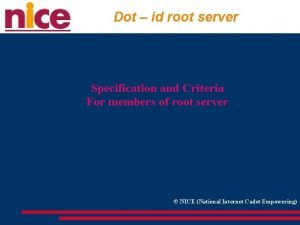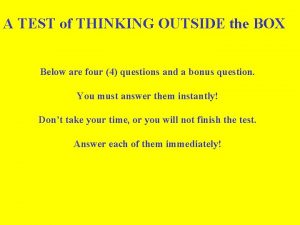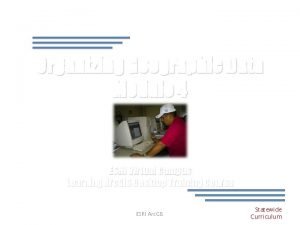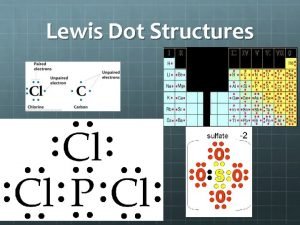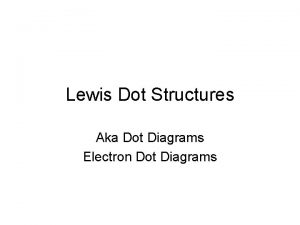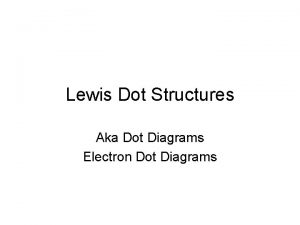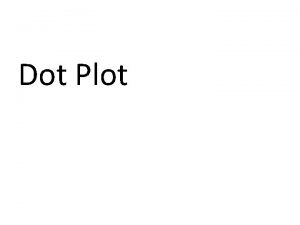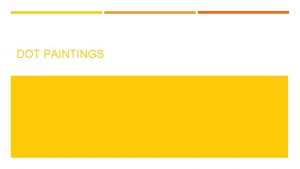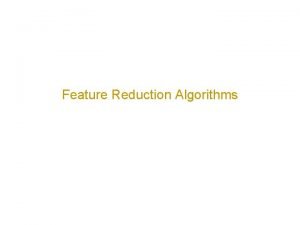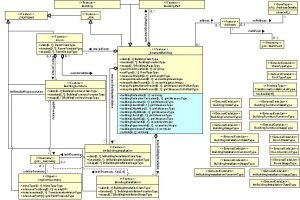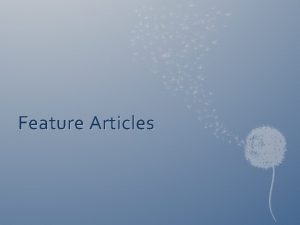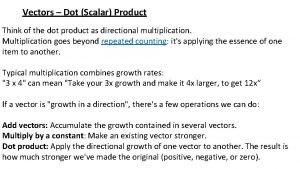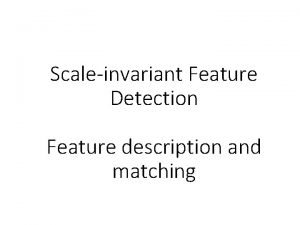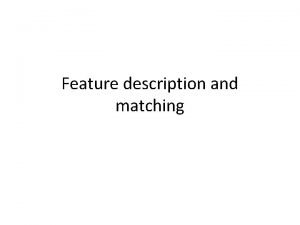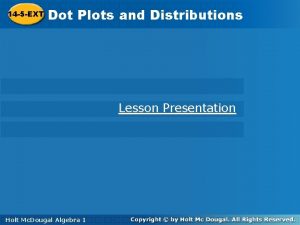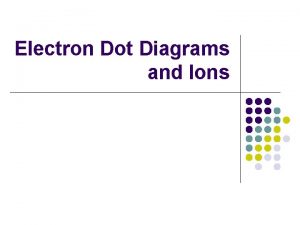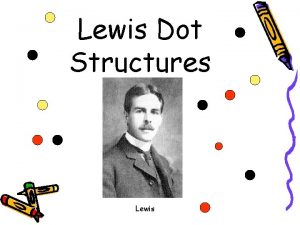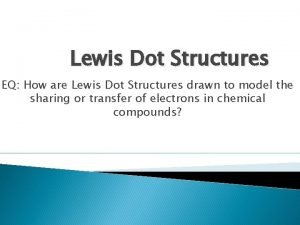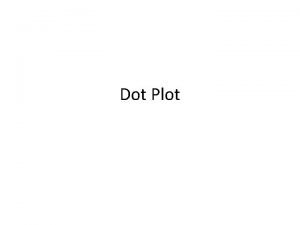Feature Description and Application Think outside the dot



















































- Slides: 51

Feature Description and Application Think outside the dot.

IDEAS Image Analysis Software • IDEAS is an image analysis application that performs high content morphometric analysis on tens of thousands of images. • Features are what IDEAS uses to quantify cell morphology. • 162 features in the default template. • 23 features per channel and 6 channels per image • • or 138 channel features. 8 additional mask based features. 16 System features. Unlimited number of user defined features. New features are continually being developed. AMNIS CORPORATION – Company Overview 11/22/2020

Which of the 162 features do I use? Centroid X, Y Intensity Centroid X, Y 1 1 AMNIS CORPORATION – Company Overview 1 1 1 1 1 1 1 1 1 1 1 1 1 1 1 1 1 1 1 11/22/2020

Feature Type IDEAS calculates two types of features • Single features are automatically calculated by IDEAS and are divided into two categories. • A) Mask based features, such as Area and Intensity. • B) System features, such as camera timer and flow speed. • Combined Features are created by combining cell based features and are defined by the user. Examples of combined features are radial delta centroid, and nuclear to cytoplasmic ratio. AMNIS CORPORATION – Company Overview 11/22/2020

Feature Hierarchy 1. Single Features (Require a Mask, 23 per channel, 31 overall) A. Mask Based Features Size: Units in pixels (Area, Perimeter, Major Axis, Minor Axis, Major Axis Intensity, Minor Axis Intensity) Signal Strength: Units are in integrated pixel values (Intensity, Mean Intensity, Minimum Intensity, Peak Intensity) Location: Units in X, Y Coordinates from an origin in the upper left (Centroid X, Centroid Y, Centroid X Intensity, Centroid Y Intensity). Shape: Defines mask shape within the image (Aspect Ratio, Aspect Ratio Intensity, Object Rotation Angle Intensity, Compactness, Elongatedness, Negative Curvature, Spot Count). Texture: Defines pixel or regional variation (Spot Small Total, Spot Medium Total, Gradient Max, Gradient RMS, Frequency) Correlation: Units in transformed Pearson’s Correlation values (Similarity, Similarity Bright Detail). B. System Features (Do not Require a Mask, 16) Object Rate: (Flow Speed, Camera Timer, Camera Line Number) Channel background: (Background Mean Intensity 1 -6, Background Standard Deviation 1 -6) Object number 2. Combined Features (User defined): (Radial Delta Centroid, Nuclear to Cytoplasmic ratio, Perimeter ^2/ Area, Peak/Mean Ratio) AMNIS CORPORATION – Company Overview 11/22/2020

Feature Mask Correlation Single features require a mask • A feature quantifies cell morphology and intensity. • A mask defines a region of interest. • The feature is generated using the pixel values within the mask from either the corrected image file (cif) or from a processed image such as the open residue image. • User defined masks can identify subcellular regions and can enhance the resolution of the feature. • Additional features can be calculated from any user defined mask or by combining features. AMNIS CORPORATION – Company Overview 11/22/2020

Types of Masks There are three types of masks • The system mask is the default mask and is designed to quantify total fluorescence. M 1, M 2 and the combined mask are system masks. • A function mask requires user input and there are 5 types of function masks. Dilate, Erode, Fill, Morphology and Threshold. • A combined mask uses Boolean logic to combine and subtract masks. An example is the cytoplasmic mask, created by taking the brightfield mask and not the morphology mask of the nucleus. AMNIS CORPORATION – Company Overview 11/22/2020

Function Masks There are five types of function masks • Dilate: Adds pixels to the outside of the starting • • mask. Erode: Subtracts pixels in from the edge of the starting mask. Fill: Fills in closed gaps in the starting mask. Morphology: Uses an algorithm to mask the fine structure within the starting mask. Threshold: Masks the brightest pixels within the starting mask. AMNIS CORPORATION – Company Overview 11/22/2020

Pixelated Imagery • 6 Channel Images are collected using a 10 bit CCD camera operated in TDI (time delay integration) mode. • Pixel values from a 10 bit detector range from 0 to 1023. • Each image is a grey scale two dimensional representation of the cell. • The color of the image is determined by the wavelengths of the channel it’s in. • A mask is applied that determines the region of interest. • Features are calculated based on the pixel values underneath the mask. AMNIS CORPORATION – Company Overview 11/22/2020

Pixelated Imagery • 6 Channel Images are collected using a 10 bit CCD camera operated in TDI (time delay integration) mode. • Pixel values from a 10 bit detector range from 0 to 1023. • Each image is a grey scale two dimensional representation of the cell. • The color of the image is determined by the wavelengths of the channel its in. • A mask is applied that determines the region of interest. • Features are calculated based on the pixel values underneath the mask. AMNIS CORPORATION – Company Overview 11/22/2020

Pixelated Imagery • These are the pixel values for a single PE image. • Light is quantified for each 0. 5 um pixel in the image, and identifies both the intensity and location of the fluorescence. • All 162 features are calculated from the digital image and include everything from total intensity to variation across the image. AMNIS CORPORATION – Company Overview 11/22/2020

Creating a New Mask and Feature Select New Mask Select Function Mask System Mask Training Cells Membrane Mask Or plot the new feature Morphology Mask Use the new mask to generate a feature Hand tag a training set of cells to test the new feature AMNIS CORPORATION – Company Overview 11/22/2020

Size Based Features • Size based features are in pixel units. • Area • Major Axis • Minor Axis • Major Axis Intensity • Minor Axis Intensity • Perimeter AMNIS CORPORATION – Company Overview 11/22/2020

Area Brightfield 1 1 1 1 1 1 1 1 1 1 1 1 1 1 1 1 1 1 1 1 1 1 Description: Area measures the number of pixels in a mask and is expressed in pixels. Applications: • Quantify and compares cell size. • Identify Single Cells. • Calculate the radius, diameter and volume of the cell. Channel 5 PI DNA 1 1 1 1 AMNIS CORPORATION – Company Overview • Identify apoptosis using the Area of the 30% Threshold mask of a nuclear dye. • Create a pseudo FSC vs. SSC plot for comparing with flow cytometry. 11/22/2020

Major Axis and Minor Axis Brightfield Fluo 4 Description: Major Axis corresponds to the longest dimension of the ellipse of best fit. Minor Axis is the narrowest dimension of the ellipse of best fit. Applications: Minor Axis • Quantify and compare cell width and height. • Identify small, medium and large cells. • Convert the radius and diameter to um. • Compare particle diameters. Data collected in collaboration with MD. Steven Sollott GRC NIH, Baltimore MD AMNIS CORPORATION – Company Overview 11/22/2020

Major and Minor Axis Intensity Brightfield Fluo 4 Major Axis Intensity Description: Major Axis Intensity is the longest dimension of the ellipse of best fit and is intensity weighted. Minor Axis Intensity is the narrowest dimension of the ellipse of best fit and is intensity weighted. Minor Axis Intensity Applications: • Quantify and compare fluorescence width and height. • Identify single cells. Data collected in collaboration with MD. Steven Sollott GRC NIH, Baltimore MD AMNIS CORPORATION – Company Overview 11/22/2020

Perimeter Brightfield Description: The perimeter measures the boundary length of the mask in number of pixels. Applications: • Quantify and compare cell circumference. Channel 5 PI DNA • Identify cells with highly irregular surfaces from smooth cells. • Perimeter of the morphology or threshold masks can identify cells with dendrites vs. those that don’t have them. . AMNIS CORPORATION – Company Overview 11/22/2020

Signal Strength Features • Signal Strength Features are measured in integrated pixel values. • Intensity • Mean Intensity • Minimum Intensity • Peak Intensity AMNIS CORPORATION – Company Overview 11/22/2020

Intensity Brightfield HLA FITC Description: Intensity is the sum of the pixel values within the mask (total intensity) minus the background intensity and is calculated using the formula; Intensity = Total Intensity – (Background Mean Intensity x Area) Applications: • Quantify relative levels of fluorescence between cells and within different regions of the same cell. • Immunophenotyping. • Cell cycle analysis. • Protein expression. • Protein activation. AMNIS CORPORATION – Company Overview 11/22/2020

Peak Intensity RTX FITC CD 45 PE Brightfield Description: Peak Intensity is the largest pixel value within the mask. This image is saturated in the FITC channel (peak intensity = 1023) but not in the PE channel. Applications: • Measure the maximum pixel value within the mask. • Identify cells that saturate the CCD. • Peak to mean ratio identifies bright punctate staining vs. uniform staining. • Plotting peak intensity vs. area of a 30% threshold mask can identify antibody capping. AMNIS CORPORATION – Company Overview 11/22/2020

Mean Intensity Brightfield CD 71 FITC Description: A Mean Intensity is the average pixel value within the mask and is calculated using the formula; Mean Intensity = Total Intensity / Area B Applications: FITC Cell A Cell B Mean Intensity 150 Peak Intensity 455 739 Total Intensity 240, 000 200, 000 AMNIS CORPORATION – Company Overview • Quantifies relative levels of mean fluorescence between cells. • Identify bright punctate spots by calculating the peak to mean ratio. • Track internalization of surface bound antibodies. 11/22/2020

Minimum Intensity Brightfield Yo. Yo 1 Description: Minimum Intensity is the lowest pixel value within the selected mask. Applications: • Quantify spectral absorbance using the brightfield image. • Identify over compensated images. • Measure the level of malaria infection in RBCs. AMNIS CORPORATION – Company Overview 11/22/2020

Location Features • Location Features are in X, Y pixel coordinates from an origin in the upper left corner. • Centroid X • Centroid Y • Centroid X Intensity • Centroid Y Intensity AMNIS CORPORATION – Company Overview 11/22/2020

Centroid X, and Centroid Y Brightfield Description: RTX AF 488 (0, 0) 32 Y 54 Centroid Y is the number of pixels from the first row of the image to the center of the mask. X Brightfield Applications: RTX AF 488 (0, 0) Centroid X is the number of pixels from the first column of the image to the center of the mask. • Identify the center of the mask. 37 Y 35 X AMNIS CORPORATION – Company Overview • Used to calculate the Delta Centroid or the distance between two fluorescent markers. • Used to calculate the Radial Delta Centroid. 11/22/2020

Centroid X and Y Intensity Centroid X, Y Intensity Description: Centroid X, Y Intensity Centroid X, Y Centroid X Intensity, is the intensity weighted X centroid and is shifted from the center of the mask toward the center of fluorescence. Centroid Y Intensity, is the intensity weighted Y centroid. Feature FITC Applications: PE Centroid X 38. 5 38. 9 Centroid X Intensity 35. 1 38. 3 3. 4 0. 6 Centroid Y 30. 7 31. 6 Centroid Y Intensity 23. 9 30. 4 6. 8 1. 2 X Intensity Shift Y Intensity Shift AMNIS CORPORATION – Company Overview • Identify the center of peak fluorescence. • Used to calculate the distance between two fluorescent markers. • Used to calculate the intensity weighted Radial Delta Centroid. 11/22/2020

Shape Features • Shape Features define the mask shape and have units that vary with the feature. • Aspect Ratio Intensity • Object Rotation Angle Intensity • Compactness • Elongatedness • Negative Curvature • Spot Count AMNIS CORPORATION – Company Overview 11/22/2020

Aspect Ratio Brightfield Composite Description: Aspect Ratio is the minor axis divided by the major axis and describes how round or oblong a mask is. Aspect ratio=0. 93 Brightfield Composite Applications: • Quantify the roundness of the mask. • Identify single cells vs. doublets. • Cell classification based on shape change. • Identify recently divided cells in mitosis. Aspect ratio=0. 32 AMNIS CORPORATION – Company Overview 11/22/2020

Aspect Ratio Intensity Brightfield Draq 5 Aspect Ratio Intensity Dq 5= 0. 31 Aspect Ratio Dq 5= 0. 61 Aspect Ratio Intensity Dq 5= 0. 31 Description: Aspect Ratio Intensity is the minor axis intensity divided by the major axis intensity. Aspect Ratio Dq 5= 0. 61 Applications: • Quantify the roundness of the fluorescent image. • Better resolution for identifying single cells vs. doublets in experiments using a DNA dye. • Cell classification based on fluorescent morphology. AMNIS CORPORATION – Company Overview 11/22/2020

Object Rotation Angle and Intensity Brightfield 7 AAD Composite Object Rotation Angle Horizontal Plane Description: Object Rotation Angle Horizontal Plane Major Axis Object Rotation Angle is the angle of the major axis from a horizontal plane in radians. Object Rotation Angle Intensity is the angle of the major axis intensity from a horizontal plane in radians. Applications: Major Axis Object Rotation Angle 7 AAD = 1. 2 Object Rotation Angle 7 AAD = 0. 83 Object Rotation Angle Intensity 7 AAD = 1. 2 Object Rotation Angle Intensity 7 AAD = 0. 81 AMNIS CORPORATION – Company Overview • Identify the orientation of an image relative to the image frame. 11/22/2020

Compactness Brightfield Draq 5 Nuclear Compactness 0. 07 0. 11 0. 16 0. 18 Lymphocytes Neutrophils Description: Compactness is computed as the deviation of the object contour from a circle with the same radius and center as the object. A perfect circle has compactness = 0, amoeboid shapes increase in compactness. Applications: • Quantify irregularities in the morphology mask. • Cell classification for identifying cell types based on nuclear morphology. • Discriminates small round shapes from amoeboid shapes. AMNIS CORPORATION – Company Overview 11/22/2020

Negative Curvatures Brightfield Negative Curvatures Draq 5 0 1 1 Description: Negative Curvature Corresponds to the number of negative and positive slope changes along the contour of the morphology mask. One positive and one negative change equals a count of 1. 2 2 3 1 Applications: 1 • Enumerate the number of inward folds in the morphology mask. 3 2 1 4 3 4 2 AMNIS CORPORATION – Company Overview • Identify cell types based on nuclear morphology. • Discriminates small round shapes from amoeboid shapes. 11/22/2020

Elongatedness Brightfield Composite AF 488 Description: Elongatedness is the ratio of the maximum width to the minimum width of the bounding rectangle of the object. 488 Elongatedness = 6. 4 Applications: • Quantify the roundness of the morphology mask. 488 Elongatedness = 2. 0 • Identify single cells vs. doublets. • Cell classification based on shape change. 488 Elongatedness = 1. 2 AMNIS CORPORATION – Company Overview • Identifies recently divided cells in mitosis. 11/22/2020

Spot Count Brightfield Babesia YOYO 1 Description: Single Parasite Two Parasites Spot Count is an integer corresponding to the number of connected components within a mask. Applications: • Enumerate the number of fluorescent particle inside a cell. • FISHIS chromosomal polysomy. • Parasitic protozoan enumeration. Three Parasites • Counting phagocytosed particles. Data collected in collaboration with Ph. D Henry Wortis Tufts Dept. of Pathology, Boston MA AMNIS CORPORATION – Company Overview 11/22/2020

Texture Features • Texture Features measure pixel or regional variation and indicate the granularity or complexity of the image. • Spot Small Total • Spot Medium Total • Gradient Max • Gradient RMS • Frequency AMNIS CORPORATION – Company Overview 11/22/2020

Spot Small and Medium Total Transferrin PE Description: Spot Small Total is the local background subtracted intensity of spots smaller then 7 pixels in diameter. Pixel values in blue are integrated into the Spot Small Total value. Transferrin Topo Map Line Profile Spot Medium Total is the local background subtracted pixel intensity of spots smaller then 14 pixels in diameter Applications: • Quantify the amount of light in small spots. • Identify cells with bright punctate staining. • Used to distinguish apoptotic cells from live cells. Intensity AMNIS CORPORATION – Company Overview • Quantifies the total intensity of small FISH spots. 11/22/2020

Gradient Max and RMS Brightfield Draq 5 Description: Gradient Max is the largest slope between any three by three adjacent pixels in the image. Gradient RMS is the over all magnitude of all the gradient values in the image and reflects gradient quadratic mean. Applications: • Quantify image crispness. • Identify cells with high contrast • Used to eliminate out of focus events. A histogram of a line that transects the image shows high Gradients for in focus cells, and low gradients for out of focus Cells. AMNIS CORPORATION – Company Overview • Identify apoptotic events, or cells with crisp bright staining. 11/22/2020

Frequency Brightfield Scatter Anxn. V_7 AAD Description: Frequency is the standard deviation of the pixel intensities under the mask, and is an indicator of texture. Applications: • Quantify light variation within a mask. Apoptotic Cells with high scatter frequency • Identify images with a high degree of variation. • Apoptotic cells may have very different scatter frequencies then live cells. • Granular cells may have higher scatter frequency. Live Cells with low scatter frequency AMNIS CORPORATION – Company Overview 11/22/2020

Correlation Features • Correlation Features compare two channel images using a log transformed Pearson’s correlation coefficient. • Similarity Bright detail AMNIS CORPORATION – Company Overview 11/22/2020

Similarity Applications: Similarity is the log transformed Pearson’s Correlation Coefficient. • Quantify translocation. Untranslocated 7 -AAD Pixel Intensity 7 -AAD image AMNIS CORPORATION – Company Overview • Identify copolarization of two probes. NF-k. B Pixel Intensity NF-k. B image NF-k. B Pixel Intensity Description: Translocated 7 -AAD image 7 -AAD Pixel Intensity 7 -AAD image 11/22/2020

Similarity Bright Detail Description: Similarity Bright Detail is the log transformed Pearson’s correlation coefficient that is non mean normalized, and is applied to the open residue image. ADC Image Endosomes image Applications: • Quantify the degree of colocalization between two probes. • Used to track internalization and intracellular trafficking of antibody drug conjugates to either the endosomes or the lysosomes. ADC Image Endosomes image AMNIS CORPORATION – Company Overview • Colocalization of Rituxan and compliment C 3 b. 11/22/2020

SBD Open Residue Image • First, To remove bright the details contribution are eroded of background, with a 7 pixel-wide an image structuring processing element step called followed the “opening by a dilation residue” to create is performed the ‘Detailon Eroded’ each images. of the image pair prior to calculation of SBD. • Next, the detail eroded images are subtracted from the originals to produce the ‘Bright Detail’ images. Original Image Detail Eroded Image Bright Detail Image • SBD measures the correlation of this final image pair. AMNIS CORPORATION – Company Overview 11/22/2020

System Features • System Features do not require a mask, and tend to deal with system wide metrics. • Object Number • Flow Speed • Camera Line number • Camera Timer • Background Mean Intensity 1 -6 • Background Standard Deviation 1 -6 AMNIS CORPORATION – Company Overview 11/22/2020

Camera Timer and Flow Speed Description: Applications: Camera Timer is the camera clock reading that starts with data acquisition and ends when the file is written. Multiplying by 0. 00182 converts the units to seconds. • Track kinetic changes in the sample during data acquisition. Flow Speed is the velocity of the core stream in mm/sec. • Track changes in fluorescent intensities over time. • Flow speed vs. Camera Timer can track velocity changes over time. 23 Flow Speed vs. Camera Timer shows the periodic variation in the flow speed that gets corrected out when data is analyzed. AMNIS CORPORATION – Company Overview Cells with large areas tapered off over the run While small cells remained at a constant concentration. 11/22/2020

Camera Line Number and Object Number Description: Applications: Camera Line Number counts the number of pixel rows that is written off the camera during acquisition. • Track kinetic changes in the sample during data acquisition. Object number is the order in which the images are collected • Track changes in sample concentration over time. Drop in cell concentration Subtle changes in the sample concentration can be observed by plotting the Object number vs. the Camera Line Number and is indicated by the slight variation in this line. . Surge in cell concentration AMNIS CORPORATION – Company Overview 11/22/2020

Background Mean Intensity and Standard Deviation Description: Applications: Background Mean Intensity is calculated by adding the intensities in the top 4 and bottom 4 rows of the image and dividing by the number of pixels. • Measure detector variation in the background of the image. • Used to subtract background from features that calculate intensity. Background Standard Deviation is the square root of the variance in the top and bottom 4 rows. BG Mean = 30. 2 30. 1 30. 0 30. 1 191. 7 30. 3 BG Stnd Dv = 1. 0 0. 96 1. 1 1. 3 1. 7 1. 5 AMNIS CORPORATION – Company Overview 11/22/2020

Combined Features • Combined features are user defined and are generated by combining base features and mathematical functions. • Radial Delta Centroid • Nuclear to Cytoplasmic Ratio • Peak Intensity / Mean Intensity • Perimeter ^2/ Area AMNIS CORPORATION – Company Overview 11/22/2020

Radial Delta Centroid Description: 44. 3 Radial Delta Centroid is the radial distance from the center of one mask to another measured in pixels. 44 0. 3 46 46 0. 0 Applications: 34. 5 56. 3 56. 5 23. 3 8. 3 48. 2 Centroid X Pixels • Quantifies the spatial relationship between two fluorescent probes. Centroid X Pixels Delta X and Y Centroid in Pixels C=√(Delta Centroid X)2+(Delta Centroid Y)2 AMNIS CORPORATION – Company Overview • Identify false apoptotic positive cells with the TUNEL and Annexin V assay. • Quantify shape change 11/22/2020

Nuclear To Cytoplasmic Ratio Brightfield Composite Description: Nuclear to Cytoplasmic Ratio is the area of the nuclear morphology mask divided by the area of the brightfield mask eroded 3 pixels and not the nuclear mask (cytoplasmic mask). Applications: Brightfield Composite • Compare the nuclear area to the cytoplasmic area. • Identify cells in metaphase. • Quantify changes in cell volume relative to nuclear volume over time. Metaphase cells have lower nuclear to cytoplasmic ratios with small nuclear area and large cytoplasmic area. AMNIS CORPORATION – Company Overview 11/22/2020

Peak to Mean Ratio Brightfield GFP Composite Description: Peak to Mean Ratio is the background subtracted Peak intensity divided by the background subtracted mean intensity Applications: • Identify bright punctate staining from diffuse staining. • Quantify cells with incomplete capping. • Identify endosomal internalization. • Identify LC 3 clustering at the autophagolysosome. Peak to Mean = (Peak Intensity – Background Mean) / (Mean Intensity – Background Mean) AMNIS CORPORATION – Company Overview 11/22/2020

Internalization Brightfield EGF Description: Internalization uses a complex mask to calculate the ratio of the brightest 50% of the pixels in the cytoplasm, divided by the brightest 50% of the fluorescence everywhere in the cell. When the brightest fluorescence is inside the cell the ratio is 1. Applications: • Quantify the fluorescence internalization. • Internalization of EGF at 37 over time. Intensity (Th 50% and Center Mask) / Intensity Th 50% AMNIS CORPORATION – Company Overview 11/22/2020

Summary • Pixelated imagery allows for the statistical analysis of cell morphology using mathematical functions called features. • Creating dot plots of single and combined features allows for an easy to understand graphical display of large data sets. • Collecting tens of thousands of images in conjunction with feature based algorithms allows for morphological discrimination and statistical analysis of unique cell types in a heterogeneous mixture. AMNIS CORPORATION – Company Overview 11/22/2020
 Id root
Id root Ramaniklal ambani
Ramaniklal ambani Thinking outside the box questions
Thinking outside the box questions Pneumonoultramicroscopicsilicovolcanoconiosis
Pneumonoultramicroscopicsilicovolcanoconiosis Think outside the chair
Think outside the chair 1-5 solving inequalities
1-5 solving inequalities Feature dataset vs feature class
Feature dataset vs feature class Isolated feature combined feature effects
Isolated feature combined feature effects Net vs java
Net vs java Why according to robin and jay are people funny
Why according to robin and jay are people funny Think fam think
Think fam think Hình ảnh bộ gõ cơ thể búng tay
Hình ảnh bộ gõ cơ thể búng tay Frameset trong html5
Frameset trong html5 Bổ thể
Bổ thể Tỉ lệ cơ thể trẻ em
Tỉ lệ cơ thể trẻ em Chó sói
Chó sói Thang điểm glasgow
Thang điểm glasgow Chúa yêu trần thế alleluia
Chúa yêu trần thế alleluia Kể tên các môn thể thao
Kể tên các môn thể thao Thế nào là hệ số cao nhất
Thế nào là hệ số cao nhất Các châu lục và đại dương trên thế giới
Các châu lục và đại dương trên thế giới Công thức tính độ biến thiên đông lượng
Công thức tính độ biến thiên đông lượng Trời xanh đây là của chúng ta thể thơ
Trời xanh đây là của chúng ta thể thơ Mật thư anh em như thể tay chân
Mật thư anh em như thể tay chân Làm thế nào để 102-1=99
Làm thế nào để 102-1=99 độ dài liên kết
độ dài liên kết Các châu lục và đại dương trên thế giới
Các châu lục và đại dương trên thế giới Thơ thất ngôn tứ tuyệt đường luật
Thơ thất ngôn tứ tuyệt đường luật Quá trình desamine hóa có thể tạo ra
Quá trình desamine hóa có thể tạo ra Một số thể thơ truyền thống
Một số thể thơ truyền thống Bàn tay mà dây bẩn
Bàn tay mà dây bẩn Vẽ hình chiếu vuông góc của vật thể sau
Vẽ hình chiếu vuông góc của vật thể sau Thế nào là sự mỏi cơ
Thế nào là sự mỏi cơ đặc điểm cơ thể của người tối cổ
đặc điểm cơ thể của người tối cổ V cc
V cc Vẽ hình chiếu đứng bằng cạnh của vật thể
Vẽ hình chiếu đứng bằng cạnh của vật thể Vẽ hình chiếu vuông góc của vật thể sau
Vẽ hình chiếu vuông góc của vật thể sau Thẻ vin
Thẻ vin đại từ thay thế
đại từ thay thế điện thế nghỉ
điện thế nghỉ Tư thế ngồi viết
Tư thế ngồi viết Diễn thế sinh thái là
Diễn thế sinh thái là Các loại đột biến cấu trúc nhiễm sắc thể
Các loại đột biến cấu trúc nhiễm sắc thể Các số nguyên tố
Các số nguyên tố Tư thế ngồi viết
Tư thế ngồi viết Lời thề hippocrates
Lời thề hippocrates Thiếu nhi thế giới liên hoan
Thiếu nhi thế giới liên hoan ưu thế lai là gì
ưu thế lai là gì Hổ sinh sản vào mùa nào
Hổ sinh sản vào mùa nào Khi nào hổ mẹ dạy hổ con săn mồi
Khi nào hổ mẹ dạy hổ con săn mồi Hệ hô hấp
Hệ hô hấp Từ ngữ thể hiện lòng nhân hậu
Từ ngữ thể hiện lòng nhân hậu
